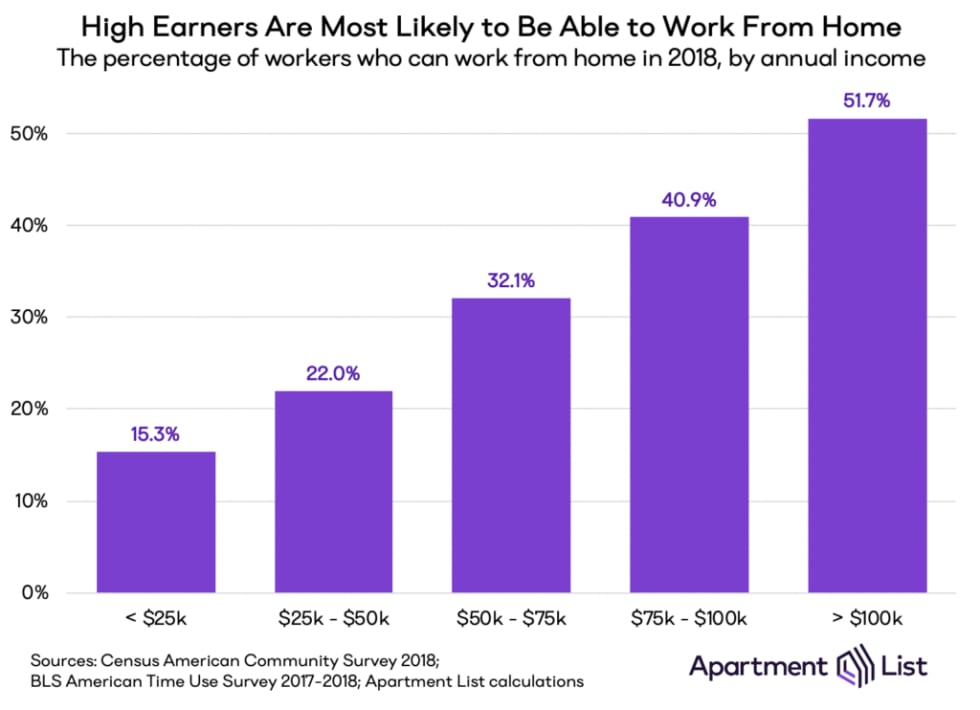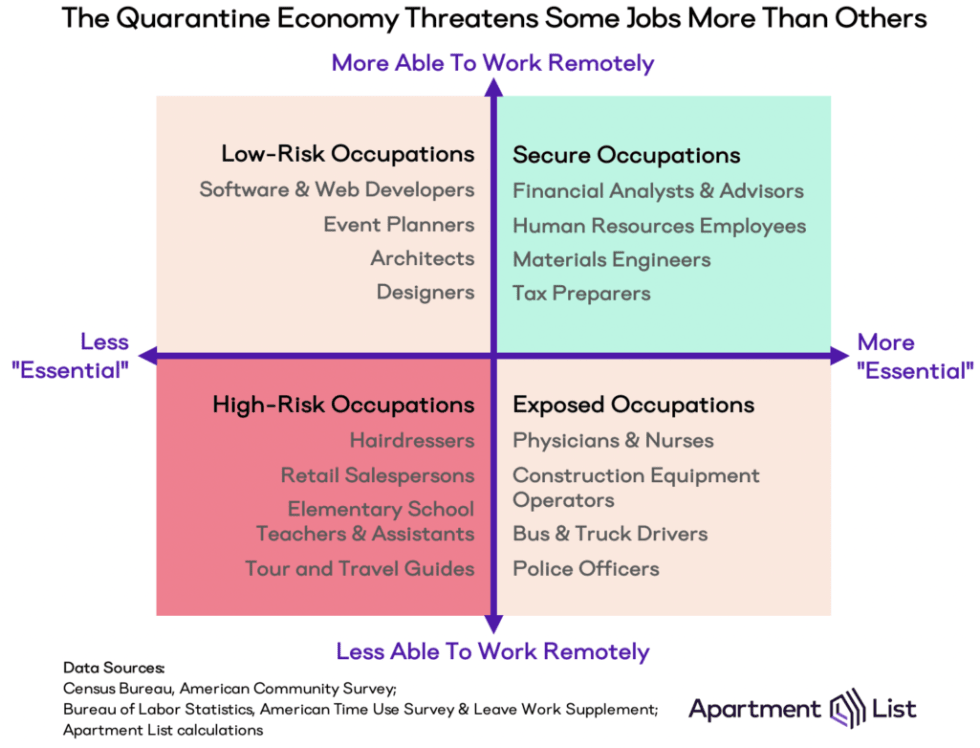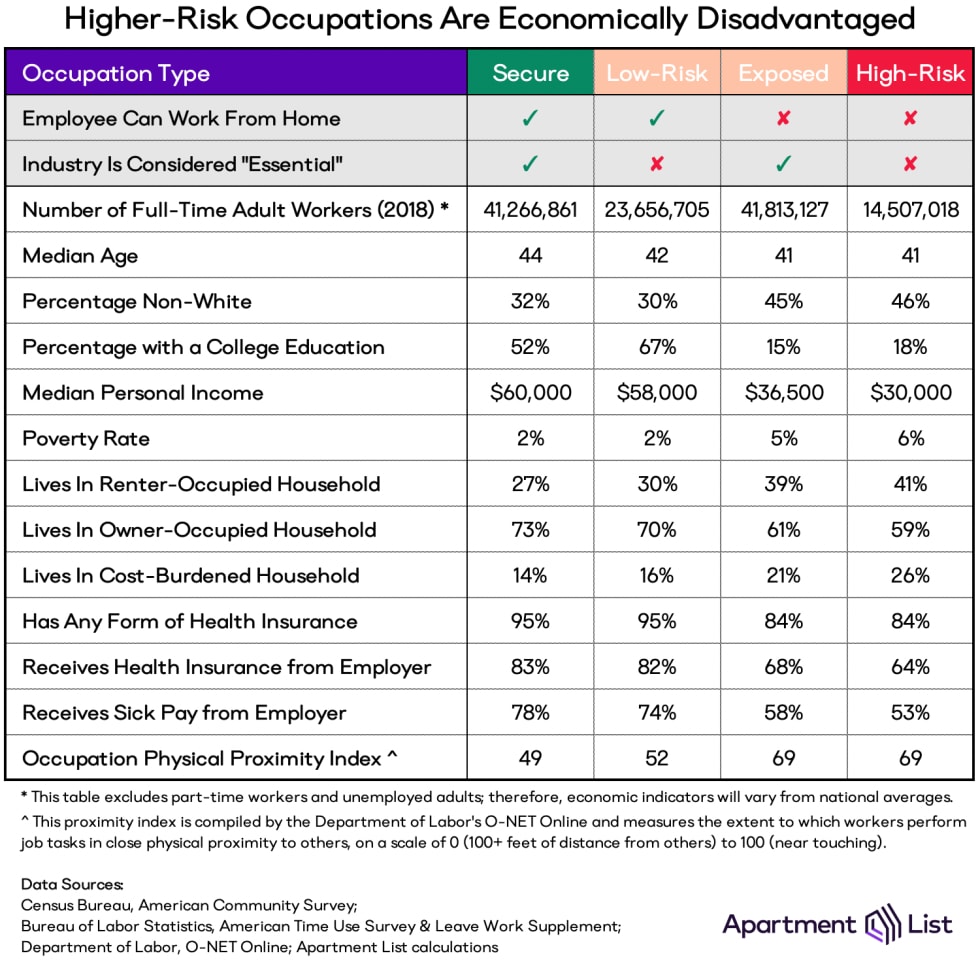The Quarantine Economy: How Coronavirus Is Worsening Economic Inequality In America

- In a matter of weeks, the coronavirus has swiftly decelerated the United States economy and eliminated millions of jobs. After analyzing data from the Census Bureau, Department of Labor, and Bureau of Labor Statistics, we determine that the fallout is landing disproportionately on those with the least ability to bear economic strain.
- In this new "quarantine economy," working from home is the most impactful thing workers can do to ensure job stability. But while remote work is becoming more popular over time, access is not universal. A much larger share of high-income earners have this luxury; many lower-wage employees do not.
- The quarantine economy creates four categories of workers, each facing varying levels of economic risk. The greatest risk is felt by those whose jobs a) are considered “non-essential” by local shelter-in-place laws and b) cannot be fulfilled at home. This includes many service sector employees, retail workers, and early educators. They tend to be lower-income, face higher housing cost burden, and have lower access to health insurance if they get sick.
- Regionally, high-risk workers comprise a larger share of the workforce in cities rooted in the tourism and service industries, particularly Las Vegas, Miami, and Orlando. Places with a high concentration of knowledge economy jobs and/or essential blue-collar industries will fare better, including metros like San Jose, Detroit, and Boston.
- Federal and state governments are rushing to pass legislation that will protect public health while reinvigorating the economy. In the meantime, job and housing insecurity will disproportionately affect millions of American workers in lower socioeconomic strata.
Download Complete Metro-Level Data
Introduction
March 2020 will likely go down as one of the most tumultuous months in world history. Although coronavirus was already dominating headlines, daily life in most places was still proceeding normally just a few weeks ago. But as confirmed cases of COVID-19 skyrocketed, the magnitude of the crisis has set in and drastic measures have been enacted to control the spread. In the United States, as in many other countries, these necessary restrictions have brought elements of the economy to a screeching halt. Downtowns which once brimmed with activity now lay quiet as tens of millions of Americans carry out their lives from the shelter of their homes. The resulting freeze in economic activity has brought an abrupt end to a decade-long bull market and ushered in the newest phase of American economic history: the quarantine economy.
As cities and states adopt increasingly drastic shelter-in-place rules, many “non-essential” businesses are forced to close while others operate at limited capacity and require their employees to work at home whenever possible. While it remains unclear how long these lockdowns will be in effect, the economic ramifications of the "quarantine economy" have already begun to take hold. Importantly, those consequences will not be distributed evenly. Quarantine-related job insecurity will fall disproportionately on the sectors of the economy that already suffer from lower incomes, greater housing cost burden, and less workplace flexibility. Furthermore, some parts of the country stand to be hit particularly hard, while others may have an easier time weathering the storm. In this report, we unpack these disparate impacts to shed light on the groups of workers and places that the quarantine economy will hurt most.
The Ability to Work From Home Is a Luxury
As the quarantine economy forces hundreds of millions indoors, the ability to work from home has emerged as a key factor in determining who can and cannot continue to do their jobs. In places where shelter-in-place orders have taken effect, employees of businesses deemed “non-essential” are told to either work remotely or not work at all. This means that workers whose jobs require in-person interaction may be at immediate risk of losing their incomes. The option to work from home may always have been seen as a perk of certain occupations, but now it has now become crucial to the economic security of workers across the country.
However, the ability to work remotely is far from universal. Using data from the Bureau of Labor Statistics and Census American Community Surveys, we calculate the percentage of workers who say they have the ability to work from home, broken down by income.1 We find a stark correlation between income and job flexibility; America’s lowest-earners are those who are least likely to be able to take advantage of remote working arrangements. Among workers who earn $100,000 annually or more, a majority (51.7 percent) say they can do their jobs from home. Meanwhile, remote work is possible for just 15.3 percent of those who earn $25,000 per year or less.

The ability to work from home also varies substantially by occupation. We have previously reported that work-from-home arrangements have risen in popularity over the past decade as teleconference technology improves. But it is mostly office workers who can take advantage of these technologies and fulfill their responsibilities from any place with a strong internet connection. Some of the economy’s most common industries—such as retail, food service, and construction—require that employees show up in person because of the very nature of the work.
There is a direct relationship between economic stability and the ability to work remotely. The chart below plots the share of workers in a given occupation who can work remotely against the share of full-time workers in that occupation who live below the poverty line. Markers are sized according to the total number of workers employed in the given occupation.
A clear pattern emerges: most occupations cluster along either the vertical or horizontal axes. Moving up the vertical axis shows occupations with increasing capability to work remotely; for many of these jobs, poverty rates hover close to zero. For example, 86 percent of full-time software developers say that they can work from home under normal conditions, and just 1.1 percent of these workers fall below the poverty line. Similarly, just 0.5 percent of lawyers are impoverished, and 75 percent report being able to work remotely.
Unfortunately, poverty is not so rare for other sets of American workers, even those working full-time. Moving to the right along the horizontal axis shows occupations with increasing poverty rates. Importantly, those with the highest poverty rates are those for which remote work is difficult or impossible. Maids and housekeepers, for example, are fully incapable of working from home, and face a poverty rate of 12.7 percent. Similarly, 11.3 percent of full-time cooks live below the poverty line. Keep in mind that the poverty threshold for an individual in 2018 was just $12,784, and for a family of four it was just $25,465. The poverty rate reflects only those facing the most extreme economic hardship, and many who fall above the poverty line still bear significant financial strain.
As the quarantine economy forces more of the workforce to go remote, the most economically vulnerable face the greatest risk of losing their income streams. This vulnerability goes beyond the size of one’s paycheck. Workers who are unable to do their jobs remotely face a number of additional hurdles. As demonstrated in the following section, they are less likely to have paid sick leave or employer-sponsored health insurance, less likely to own homes, and more likely to be burdened by the cost of housing.
Which Workers Are At Greater Economic Risk?
A key component of the today's shelter-in-place orders are the exceptions granted to workers employed in industries that are deemed “essential.” Earlier we described the general economic benefits of jobs that allow remote work. But in the quarantine economy, this concept of essentiality is an equally important factor in identifying which workers will face the greatest economic risk.
Essentiality varies slightly from place to place, but is based on federal guidelines about what constitutes “critical infrastructure” during the coronavirus pandemic.2 For the most part, jobs related to manufacturing, agriculture, medicine, government services, and national defense are considered essential. Others, like education, entertainment, and some retail are non-essential. Employees of non-essential businesses are therefore prevented from working, that is, unless they can work from home.
Combining the concepts of essentiality and remote work provides us with a more nuanced breakdown of the American labor force and tells us who is at the greatest risk of economic uncertainty during the quarantine economy. Using several shelter-in-place laws as a guide, we categorized detailed lists of industry and occupation codes according to essentiality and remote work capability. The result is four distinct types of work, summarized in the diagram below:
- Secure jobs are the least threatened. They are not only essential to the economy but also flexible in their working arrangements. These workers are likely to retain their usual income while also practicing social distancing that will keep themselves and their families at low risk of coronavirus exposure.
- Low-Risk jobs provide shelter from the coronavirus, but carry some risk of economic uncertainty. These workers can easily transition to a remote environment but their paychecks may be in jeopardy if demand for their skills weakens in an economic downturn.
- Exposed jobs are those that are deemed essential, but must be done in person. These jobs generally offer economic stability during the crisis, but may increase individual exposure to health risks. These workers cannot shelter-in-place while working because the nature of their job requires leaving home and engaging in some level of personal contact.
- High-Risk jobs are the most economically at-risk in the quarantine economy. These workers are deemed “non-essential” by federal guidelines and furthermore do not have the option to work from home. Heavily concentrated in the service sector, the incomes of many high-risk workers are already in jeopardy today.

The quarantine economy concentrates job insecurity among workers already in lower socioeconomic strata. High-risk and exposed workers have lower-incomes and poorer health coverage. They are also younger, less-educated, and more ethnically diverse. High-risk workers in particular—non-essential workers who cannot work remotely—can least afford the economic challenges they are likely to face; their median income ($30,000) is half that of many who can work from home. Furthermore, they are nearly twice as likely to live in a cost-burdened household, meaning they already pay over 30 percent of their income on housing. Cutting their hours, or losing their jobs altogether, could have a disastrous effect on millions of families’ ability to afford housing.3 Fortunately, the federal government (as well as several states and major cities) have already placed moratoriums on evictions and foreclosures to provide short-term relief while Americans shelter in place. Nevertheless, unpaid rent will create long-term pressure for families whose incomes are jeopardized.

Exposed workers are more likely to keep their jobs, by virtue of their essentiality.4 However, the quarantine economy will expose them to new and unequal health risks. Essential work that cannot be performed at home must be performed in some proximity to others, elevating the risk of exposure to the coronavirus. The Department of Labor releases occupation-level statistics on one's proximity to others while performing job duties. Values range from 0 (working >100 feet away from others) to 100 (nearly touching others while working), and the median value for exposed workers is 69, roughly equal to being within arms-length of others.5 This places them well within the six feet of separation that the CDC recommends while in public. Not only are these individuals at a higher risk of getting sick, if they do, they are less likely to have an employer-sponsored safety net. Over 30 percent do not receive health insurance from their jobs (although some supplement the gap with private and/or public coverage), and nearly half receive no sick pay.
Tourism and Service-Based Economies Will Be Hit Hardest
Based on the classification above, high-risk workers are those unable to work remotely and deemed “non-essential” by the prevailing shelter-in-place guidelines. They are at immediate risk of losing their paychecks, a blow that is compounded by the fact that they are concentrated in low-wage occupations. But in addition to this occupation-level clustering, the high-risk workforce is also clustered geographically, making up a much larger share of the workforce in parts of the country where the local economy is rooted in the tourism and service sectors. In the map below, metros are shaded by the share of the workforce comprised of high-risk workers, with marker size corresponding to the total population of high-risk workers.
Download Complete Metro-Level Data
Among the nation’s 50 largest metropolitan areas, Las Vegas has by far the largest share of workers facing immediate economic risk from the quarantine economy. A staggering 25.5 percent of Vegas’s full-time workforce is defined as high-risk based on our classification. Even more concerning is that our categorization is likely undercounting the true number of workers facing immediate job insecurity. Many employers in industries deemed “essential” -- restaurants and some retail stores, for example -- have still cut hours and laid off workers due to decreased demand, and these cuts would not be captured in our conservative calculations.
The Las Vegas economy is dominated by tourism, a fact which makes it highly sensitive to economic cycles even outside of the unique circumstance of the current pandemic. In times of economic uncertainty, tourism, recreation, and gambling are some of the first areas of discretionary spending that households cut back on. This is one of the reasons Las Vegas was hit so hard during last decade’s Great Recession, and it will be one of the reasons it is hit hard again by the quarantine economy.
Ranking a fairly distant second, Orlando has the second highest share of high-risk workers at 16.0 percent, followed by Miami (15.8 percent). Similar to Las Vegas, Orlando and Miami both have robust tourism sectors, although they each have somewhat more diversified economies. Other metros with a high share of high-risk workers include Riverside, CA and Oklahoma City. These metros are not driven by tourism, but still have a large share of their workforces employed in service occupations in non-essential industries.
At the other end of the spectrum, high-risk workers comprise just 7.8 percent of the workforce in San Jose, the lowest share among the 50 largest metros. The San Jose economy is dominated by the Silicon Valley tech industry, with a disproportionate share of the region’s workforce employed in occupations that are performed largely on computers and can thus be done remotely. Other knowledge hubs also have relatively low shares of high-risk workers, such as Boston (9.6 percent) and Washington, DC (10.2 percent).
Notably, a number of working-class Rust Belt metros are also poised to experience a more muted impact from the quarantine economy. Milwaukee and Detroit have the second and third lowest shares of high-risk workers, at 8.4 percent and 9.4 percent, respectively. In contrast to the knowledge hubs described above, these economies actually have below average shares of workers who are able to work remotely. Rather, their low shares of high-risk workers are attributable to having a concentration of essential industries. In Detroit, for example, automotive manufacturing has long been the largest industry. Although auto workers who are directly involved in that manufacturing must do their jobs in-person, they are still allowed to do so by virtue of having been deemed essential.
Conclusion
As the coronavirus continues to surge through the nation, the economic fallout will be severe and unequal. While many speculate how long it will take the economy to recover, a recession of some magnitude is becoming a foregone conclusion. The requirement to shelter in place, however, makes this downturn unique. Unlike previous economic contractions, in which job losses occurred gradually, the quarantine economy has caused millions of jobs to essentially disappear overnight, at least temporarily. These losses are happening to workers who have the least ability to bear the economic strain.
A growing recognition of the magnitude of the quarantine economy seems like it will result in the federal government passing a broad package of economic relief measures. A $2 trillion stimulus has been unanimously approved by the Senate and is expected to reach the president's desk for approval by the end of the week. The bill will strengthen unemployment benefits and send direct payments to most American workers, including gig workers. Although these measures will provide a much needed buffer, the most at-risk workers will likely still face significant struggles if the quarantine economy persists for an extended period of time.
In these unprecedented times, shelter-in-place mandates have flipped our normal lives on their heads and thrust us into the new reality of the quarantine economy. Workers who are able to fulfill their job duties remotely have been largely insulated from the short-term fallout, yet longer-term impacts remain to be seen. And these workers do not represent the entire nation; they tend to be wealthier, whiter, more-educated, and have broader health coverage. On the other end of the spectrum are America’s lower-income, diverse workforce who face a combination of job insecurity and health risks. As the quarantine economy progresses, these workers will, at best, face higher threat of exposure as they continue to travel for work, or at worst, unemployment.
- Note that data on the ability to work from home refers to working arrangements under normal conditions. Many workers whose employers may not normally allow them to work from home are likely still capable of doing so during the present circumstances.↩
- The US Cybersecurity and Infrastructure Security Agency identifies "16 critical infrastructure sectors whose assets, systems, and networks, whether physical or virtual, are considered so vital to the United States that their incapacitation or destruction would have a debilitating effect on security, national economic security, national public health or safety, or any combination thereof."↩
- Cost burden rates are lower here than in previous articles published by our team. This is because this analysis looks only at full-time employed workers, who naturally have lower cost burden rates than the part-time or unemployed individuals who are not included in this table.↩
- It should be noted that while deemed "essential", these workers are also subject to job insecurity from reduced demand and/or restriction on business operations. The most salient example of this today is waiters and servers, who work at essential businesses (restaurants) but are losing jobs rapidly as many restaurants are limited to just take-out service.↩
- Low-proximity occupations include fine artists (9) and loggers (14), while close-proximity occupations include choreographers (100) and dental hygienists (100).↩
Share this Article

